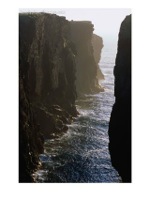Difference between revisions of "Chasm"
m (Text replacement - "http://" to "https://") |
|||
| Line 3: | Line 3: | ||
==Origin== | ==Origin== | ||
Latin ''chasma'' , < Greek ''χάσμα'' yawning hollow; Latin ''hiare''. The Greek-Latin form ''chasma'' was used for some time unchanged. | Latin ''chasma'' , < Greek ''χάσμα'' yawning hollow; Latin ''hiare''. The Greek-Latin form ''chasma'' was used for some time unchanged. | ||
| − | [ | + | [https://en.wikipedia.org/wiki/16th_century 1596] |
==Definitions== | ==Definitions== | ||
*1: a deep cleft in the [[surface]] of a [[planet]] (as the [[earth]]) : gorge | *1: a deep cleft in the [[surface]] of a [[planet]] (as the [[earth]]) : gorge | ||
*2: a marked division, [[separation]], or [[difference]] | *2: a marked division, [[separation]], or [[difference]] | ||
==Description== | ==Description== | ||
| − | In [[geology]], a rift or '''chasm''' is a place where the [[Earth]]'s [ | + | In [[geology]], a rift or '''chasm''' is a place where the [[Earth]]'s [https://en.wikipedia.org/wiki/Crust_(geology) crust] and [https://en.wikipedia.org/wiki/Lithosphere lithosphere] are being pulled apart and is an example of [https://en.wikipedia.org/wiki/Extensional_tectonics extensional tectonics]. |
| − | Typical rift features are a central linear [ | + | Typical rift features are a central linear [https://en.wikipedia.org/wiki/Fault_(geology) downfaulted] segment, called a [https://en.wikipedia.org/wiki/Graben graben], with [[parallel]] normal faulting and rift-flank uplifts on either side forming a [https://en.wikipedia.org/wiki/Rift_valley rift valley], where the rift remains above sea level. The [[axis]] of the rift area commonly contains [https://en.wikipedia.org/wiki/Volcanic_rocks volcanic rocks], and active volcanism is a part of many, but not all active rift systems. |
| − | Major rifts occur along the central axis of [ | + | Major rifts occur along the central axis of [https://en.wikipedia.org/wiki/Mid-ocean_ridge mid-ocean ridges], where new oceanic crust and lithosphere is created along a divergent boundary between two [https://en.wikipedia.org/wiki/Tectonic_plate tectonic plates]. |
| − | Failed rifts are where continental rifting began, but then failed to continue to the point of break-up. Typically the [[transition]] from rifting to spreading develops at a [ | + | Failed rifts are where continental rifting began, but then failed to continue to the point of break-up. Typically the [[transition]] from rifting to spreading develops at a [https://en.wikipedia.org/wiki/Triple_junction triple junction] where three converging rifts meet over a [https://en.wikipedia.org/wiki/Hotspot_(geology) hotspot]. Two of these evolve to the point of seafloor spreading, while the third ultimately fails, becoming an [https://en.wikipedia.org/wiki/Aulacogen aulacogen]. |
==See also== | ==See also== | ||
'''''[[Abyss]]''''' | '''''[[Abyss]]''''' | ||
[[Category: Earth Science]] | [[Category: Earth Science]] | ||
Latest revision as of 23:40, 12 December 2020
Origin
Latin chasma , < Greek χάσμα yawning hollow; Latin hiare. The Greek-Latin form chasma was used for some time unchanged. 1596
Definitions
- 1: a deep cleft in the surface of a planet (as the earth) : gorge
- 2: a marked division, separation, or difference
Description
In geology, a rift or chasm is a place where the Earth's crust and lithosphere are being pulled apart and is an example of extensional tectonics.
Typical rift features are a central linear downfaulted segment, called a graben, with parallel normal faulting and rift-flank uplifts on either side forming a rift valley, where the rift remains above sea level. The axis of the rift area commonly contains volcanic rocks, and active volcanism is a part of many, but not all active rift systems.
Major rifts occur along the central axis of mid-ocean ridges, where new oceanic crust and lithosphere is created along a divergent boundary between two tectonic plates.
Failed rifts are where continental rifting began, but then failed to continue to the point of break-up. Typically the transition from rifting to spreading develops at a triple junction where three converging rifts meet over a hotspot. Two of these evolve to the point of seafloor spreading, while the third ultimately fails, becoming an aulacogen.
